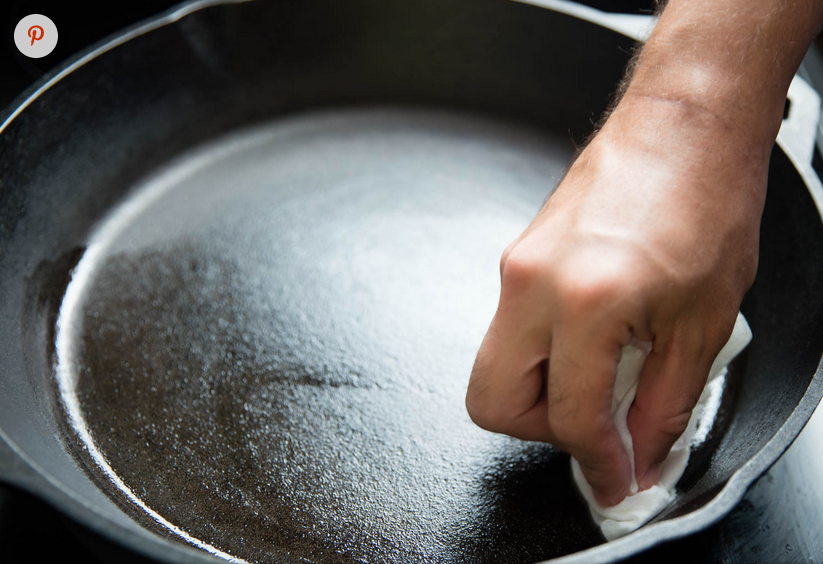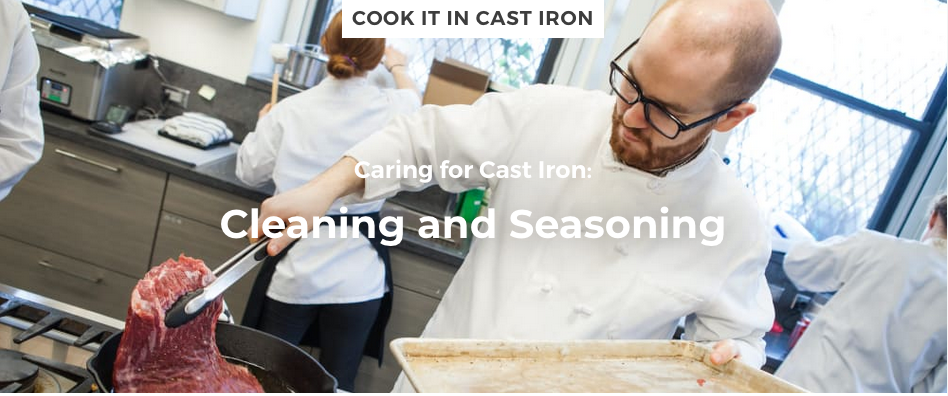
Source: https://www.seriouseats.com/2016/09/how-to-clean-maintain-cast-iron-pan-skillet-cookware.html
I know I told you way back at the start of the semester (so long ago, right??) that I would write a post on how to season a cast iron pan. Well, promise kept! But before I launch into the “how-to”s, let’s clear up a few common questions and misconceptions about cast iron care first.
First of all, what does “seasoning” a cast iron pan really mean?
A lot of people think that it means “adding flavor”, (like adding seasoning to your food), but no. Do not let your rancid old grease hang out for days in the bottom of your unwashed pan and call that seasoning – yuck! “Seasoning” in this sense is more like conditioning – think “seasoned firewood”, for instance. In regards to cookware, it actually means building up a layer of polymerized fat on the pan, which in turn causes the pan to a) become non-stick and b) resist the natural rusting to which iron is otherwise prone.
Why cast iron?
Why not just use non-sticks pans, you ask? Because gross, that’s why. As with cast iron seasoning, non-stick seasoning comes off with harsh scrubbing and scraping (especially when using metal implements) – and then that stuff gets into your food (and, to add insult to injury, your pan irredeemably ceases being non-stick in the process). While the EPA declares that currently-manufactured non-stick chemicals are safe below certain temperatures (at which time they release toxic chemicals into the air), nonstick coatings manufactured before 2015 contained PFOA (perfluorooctanoic acid), which is a likely carcinogen. This means that if you buy your pans used from a thrift store or a yard sale – like many people do – they probably contain PFOA.
But besides avoiding non-stick pans, why cast iron specifically, vs. stainless steel, for instance? For one thing, when cared for properly, cast iron gets better and better with every use. Cast iron pans can last for generations – much longer than other types of pans. They also hold heat longer. Here is what America’s Test Kitchen has to say about it.
How to clean and season cast iron
Anyhoo.., back to the topic of seasoning cast iron. It turns out that there is plenty of debate about the “right” way to season and maintain cast iron cookware. Some people, for instance, get very upset if a cast iron pan is washed with soap, although others argue that most modern dish soaps are mild enough not to have a significant impact on the seasoning.
What is generally agreed on:
- Don’t use steel wool or other harsh abrasives on cast-iron, as they can remove the seasoning.
- Don’t leave acids (tomatoes, vinegar, etc.) in the pan for long, as this will also remove the seasoning.
- Don’t soak cast iron for long periods in water, as the iron is often full of pinholes and soaking will lead to rust.
- After washing, heat and oil pans to drive off water and prevent rust. (See below for instructions.)
- High temperature oils/fats (such as canola, flax, etc.) are best for the seasoning (vs low-temperature oils like olive oil). See the previous post on cooking oils for more information.
What is not generally agreed on:
- What temperature is required for seasoning pans
- How long to heat a pan to fully season it
- Whether you can wash with soap or not
Basic maintenance
If you have bought a new pan, it has almost certainly come pre-seasoned. In that case, or if you otherwise have a pan in good shape, you will just need to do basic maintenance, which includes drying and lightly oiling your pan after every use.
- Wash your pan thoroughly, using the rough side of your sponge to remove any stuck-on food. Do NOT use steel wool. You can also use a good sprinkling of salt as an abrasive, rubbing with a scouring pad.
- Once clean, dry the pan by placing it back on the stove on med-high heat until all the water has evaporated.
- At that point, lightly oil the pan with canola, sunflower, or other high-temperature oil, using a paper towel. You will only need a very small amount of oil – if you have the slightest doubt that it is too much, it is. Your long-term goal is a glossy patina that is dry to the touch – it should not be sticky or beaded up in any way. If the hot oil starts to form beads, wipe it off to remove the excess oil.
- At this point, some people will remove the pan from the heat and be done. I personally usually take the oil to the smoke point, as in my opinion (not based on any actual facts), this helps build the seasoning layer. However, if you are in a hurry or your pan is in terrific shape, it seems fine to keep the heat lower, as long as there is no sticky oil residue left in the pan when you are done.
If your pan is in bad shape
If your pan is rusty or in bad shape, more thorough work is needed. First, thoroughly clean and dry the pan, as described above. Make sure to scrub all of the pan, including the outside, the bottom, and the handle. Apply a very light layer of canola, flax, or other high heat oil to the entire pan – top, bottom, sides – all of it. Apply with a paper towel and ensure there isn’t any excess oil at all. Turn the pan upside down and put it in the oven.
Here is where a lot of the online arguing comes in: What is the right temperature for seasoning? 300 degrees? 500 degrees? For how long? Half an hour? An hour?
I tried to research this because “does polymerization occur at X temperature for Y duration with Z type of oil?” is a matter of fact, not opinion. (Try telling that to the internet.) What I found out by researching polymerization is that it often occurs over a range of temperatures – which perhaps accounts for the general confusion. I couldn’t find anything about duration, but I’m not a chemist and at this point in my research I was in way over my head. If you are a chemist and think this sounds like a fun research project, go for it! I would certainly love to hear what you find out.
Useful how-to sites
At any rate, here are a few of the most useful websites I found to give you a quick overview of cleaning and seasoning, and some video instructions. They mostly come down on the “high heat for an hour” side of things – but, as I said, I can’t tell you for sure if that is necessary or not. One friend with a lot of cast iron experience says 300 for an hour is fine. You could experiment yourself and find out!
From America’s Test Kitchen: https://www.americastestkitchen.com/guides/cook-it-in-cast-iron/cleaning-and-seasoning-a-cast-iron-skillet
From Serious Eats: https://www.seriouseats.com/2016/09/how-to-clean-maintain-cast-iron-pan-skillet-cookware.html
From Tasty (Note: unfortunately, the last sentence in this video is somewhat objectionable; also, they reference finishing off food in the oven – which may be great if you are a real foody, but I have certainly never found to be necessary. I include this video because, despite these drawbacks, of the three it provides the shortest and easiest to understand video.)




Pingback: Best Deep-Dish Pizza Pan – Serve Your Family Perfect Pizza
Pingback: How to Season a Cast Iron Pan With Avocado Oil [Simple Steps to a Perfectly Seasoned Pan] - Outdoor Happens
Pingback: How To Clean and Season Cast Iron Cookware